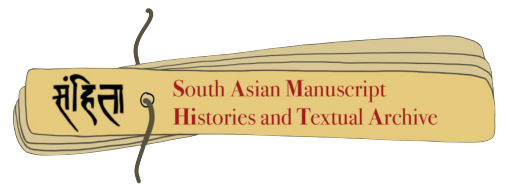Manuscripts
Search Filter
Mudrārākṣasa
EAP1023/25/20 Language : Sanskrit Scripts : Newari
An incomplete manuscript of the Sanskrit play by Viśākhadatta on the ascent to power of King Candragupta Maurya, dated to the sixth century CE. The seventh (last) aṅka is incomplete.
Rāghava Pānḍaviya Mahākāvya
EAP1023/25/21 Language : Sanskrit Scripts : Devanagari
This contains all 13 sarga-s of the mahākāvya by Kavirājapaṇḍita, which uses śleṣa to narrate the Rāmāyaṇa and Mahābhārata simultaneously. Kavirājapaṇḍita (or Kavirāja Sūri) was court poet of ‘Vīra’ Kāmadeva II (1182–87) of the Kādambas of Jayantīpura (Karnataka region). The first three folios have marginal notes explaining the double meanings. A pencilled note on the cover refers to the tīkā (commentary) by Śaśidhara, which seems to have formed the second part of the manuscript, going by the folio numbers. The last folio shifts from Newari to Devanagari to elaborate on the simultaneous references to Sitā/Draupadi.
Mahākala Saṁhitā
EAP1023/25/22 Language : Sanskrit Scripts : Newari
This is a tantra text derived from the Bhīmātantra of the Mahākāla Saṃhitā, containing vīja-upavīja mantras. The Mahākāla Saṃhitā is a tantric text associated with Goddess Mahākālī and ascribed to Ādināth. It is dated to the 10th century.
Śiśupālavadha
EAP1023/25/24 Language : Sanskrit Scripts : Devanagari
The first ten cantos of Śiśupālavadha, one of six Sanskrit mahākāvya-s. Composed by Māgha in the 7th or 8th century CE, it has 20 cantos of about 1,800 ornate stanzas. Marginal notes in fluid lines and occasional pictorial elements (18r) are found up to the third canto, recalling Māgha’ creation of citra kāvya-s where syllables can be rearranged to create different shapes without loss of meaning. The scribe was Lilānātha Upādhyāya Śarman. The manuscript is dated Saṃvat 1950 (1893 CE).
Kālikā Sahasranāma Stotra
EAP1023/25/25 Language : Sanskrit Scripts : Devanagari
A stotra invoking the thousand names of Kālikā Devī (Goddess Kālī), derived from the Śiva-Paraśurāma Saṃvāda of the Kālikākulasarvasva.
Jayākhya Saṁhitā
EAP1023/25/27 Language : Sanskrit Scripts : Newari
This is one of the three authoritative texts of the Pancarātra Āgama revered by Vaiśnava-s, and is dated to the fifth century CE. Also known as Jñānalakṣmī, it has 33 paṭala-s, and deals with tantric and smārta topics. This manuscript contains the eighth and part of the ninth paṭala. Folio 18r states that the work was composed by Sādhakacandra, who received favour from Ekāyanācārya Nārāyaṇagarbha: according to tradition, Pancarātra literature originates from Nārāyaṇa, and its source is the Ekāyanā Śākhā affiliated with one of the Vedas.
Jayākhya Saṁhitā
EAP1023/25/28 Language : Sanskrit Scripts : Newari
This is one of the three authoritative texts of the Pancarātra Āgama revered by Vaiśnava-s, and is dated to the fifth century CE. Also known as Jñānalakṣmī, it has 33 paṭala-s, and deals with tantric and smārta topics. This manuscript contains the first seven paṭala-s. (the first and seventh incomplete). It represents the section previous to EAP1023/25/27.
Śīghrabodha
EAP1023/25/29 Language : Sanskrit Scripts : Newari
A complete text of a work on astrology by Kāśīnātha (flourished before 1559), which was copied extensively and consists of four prakaraṇa-s: vivāhaprakaraṇa, muhūrtaprakaraṇa, arghaprakaraṇa and ketūdayādiphalaprakaraṇa or saṃvatsaraprakaraṇa. The scribe was Kotirāja, and the manuscript is dated Nepal Saṃvat 860 or 1709 CE.
Saundaryalaharīstotra
EAP1023/25/31 Language : Sanskrit Scripts : Devanagari
A complete text of the hymn to Goddess Tripurasundarī authored by Śaṃkarācārya: ‘Ānandalaharī’ (Verses 1–41) and, ‘Saundaryalaharī’ (Verses 42‒102). The manuscript is dated Śaka 1622 or 1700 CE.
Rudra Paddhati
EAP1023/25/32 Language : Sanskrit Scripts : Devanagari
Also known as Rudrānuṣṭhānapaddhati, this is a dharmaśāstra text that describes paddhati-s in accordance with Vedic mantras. It is ascribed to Nārāyaṇa-bhaṭṭa (Vārānasi, born 1513 CE). The manuscript contains Śuddhimantras (2r–2v), Pañcamahāvyāhṛti (4v, 5r), Nyāsa paddhati, or mantra-s to invoke Śiva with every body part, Rudrāhvānaviniyoga (16r), Rudrastuti (22r). The text quotes Śivadharmottara and Viṣṇudharmottara. The scribe was Bhesarājaśarman, and it is dated Saṃvat 1956 and Śaka 1821, or 1899 CE.
Sarasvatī Stotra
EAP1023/25/33 Language : Sanskrit Scripts : Devanagari
The stotra is in 12 verses including the phalaśruti. The opening lines refer to the work as the japa-viniyogaḥ (way of praying) to devata Sarasvatī, and to Mārkaṇḍeya and Āśvalāyana as the ṛṣis of the stotra, and anuṣṭupa as the metre. The colophon says it is from the Brahmāṇḍapurāṇa, ‘Nāradanandikeśvarīsaṃvād’, and that Raghu, owner of the manuscript, copied it out himself.
Rudra Parājitāmahavidyā Stotra
EAP1023/25/34 Language : Sanskrit Scripts : Devanagari
This stotra text invoking Mahāvidyā is from the Rudrayāmala Tantra. The opening lines refer to it as the japa-viniyogaḥ (way of praying) to devatā Śiva for the fulfilment of one’s wishes, and to Aryamā as the Ṛṣi, and the metre as Gāyatrī. The scribe was Kāśinātha, and Candraśekhara owned the manuscript. It is dated Śaka 1739 (1817 CE).













